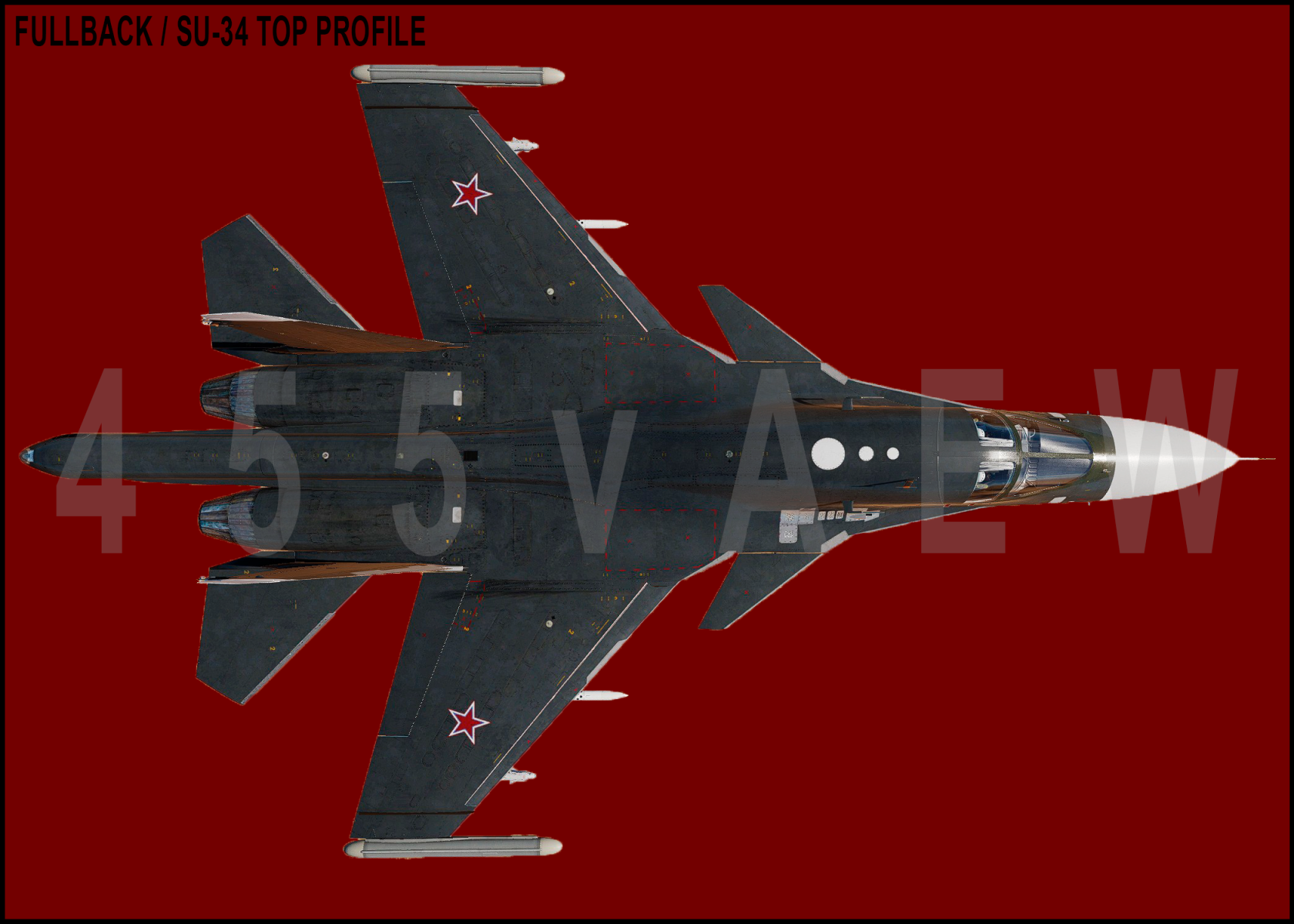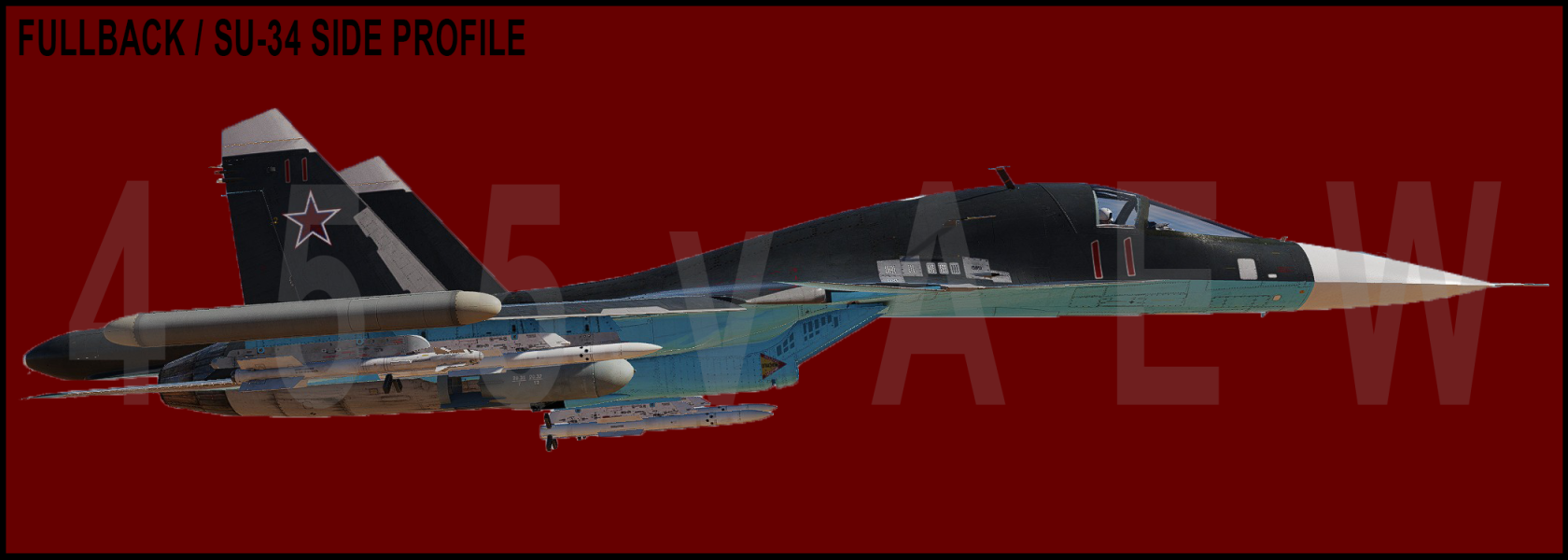FULLBACK / SU-34
The Su-34 aircraft is a multi-role deep strike fighter, intended to perform the battlefield interdiction, close air support and deep strike roles now performed by the Su-24 in Russia. In addition, the Russians envisage a long endurance / range air combat role for the aircraft, with the intent to use it to attack ISR platforms with standoff missiles; in this respect its tasking reflects early US Air Force thinking on the F-111 series. The manufacturer's website states that the Su-34 is designed to defeat the F-15, F/A-18 and Eurofighter Typhoon in air combat engagements. Like the Su-24 Fencer, the Su-32MF/34 is expected to be used for derivative roles. For tactical reconnaissance, the likely candidate pod is the recently revealed M400 centerline pod. It is equipped with a Raduga multi-band) IR imaging system, AP-403 and AP-404 panoramic cameras, and optional modules with the M402 Pika SLAR radar and AK-108FM oblique camera.
Airframe
- Length -
- Wingspan –
- Height –
- Wing Area –
- Empty Weight –
- Combat Weight –
- Max Takeoff Weight –
- Wing Loading –
- Power Plant
- 2×
- X lb wet thrust
- X lb dry thrust
- Engine Smoke: TBD
- Cockpit Visibility: Fair
- AAR Capabilities: None
Aerodynamic Handling
TBD
Turn / Dogfight Capabilities
- Instantaneous Turn –
- Sustained Turn –
- Max AOA –
- Max-G
- Above M0.85 -
- Below M0.85 -
- Vertical - High
- Horizontal - High
- Trust Rate Ratio:
Combat Radius
- Combat Radius -
- Ferry Radius -
Search / Track Ranges
TBD
ECCM Features - Burnthrough Ranges
TBD
Look-down/Shoot-down Capabilities
TBD
Defensive RWR
TBD
Expected Contact Ranges
RWR Indications
Air to Air Armament
Defensive Systems
Strengths and Weaknesses
Countertactics
TBD
FULLBACK Counter Threat Timeline
Refer to 455vAEWTTP 3-1.F-16 Attachment 2
Threat Replication Guidance
Refer to 455vAEW / 18th vAGRS
For air combat the aircraft will be equipped to carry the same R-27 (AA-10 Alamo), R-73 (AA-11 Archer), and R-77 (AA-12 Adder) AAMs now carried by the Su-27/30. This will provide a credible BVR capability against closing fighters and allows the Su-34 to be retasked as an air defense interceptor. The radar's GMTI capability is likely to be exploited for cruise missile defense
tasks. Air to ground weapon payloads for the Su-32MF/34 will include all of the stores currently cleared on the Su-35, Su-30MK and Su-27SKM. Beyond the weapons envisaged during the early development of the aircraft, the Kh-65 cruise
missile has been discussed in EU reports - three could be carried. It is likely the satellite aided inertially guided KAB-500/1500S-E will be included in any production configuration. Russian reports claim the aircraft was trialed in Chechnya.
Avionics
The primary aircraft sensor is the large Leninets B-004 multimode phased array radar, which uses like all current Russian designs passive phase shifter technology with a Traveling Wave Tube (TWT) transmitter. The radar is claimed to be highly modular
with redundant components, reflecting the APQ-164 model to achieve very high mission reliability on long endurance sorties. The X-band design is claimed to achieve a 15 kW peak power rating, although production radars could see the use of higher rating TWT transmitters since developed for the NIIP BARS series. The radar is claimed to provide a range of 200 to 250 km (108 to 135 NMI) against large surface targets, ground mapping capability to 150 km (81 NMI), Doppler beam sharpened ground mapping to 75 km (40 NMI) and GMTI target tracking to 30 km (16 NMI), the latter similar to contemporary Western attack radars like the APG-76. Detection performance against fighter sized aerial targets is claimed to be 90 km (48.6 NMI), comparable to the N-001 series. A Synthetic Aperture Radar high resolution groundmapping mode was planned, and given its existence in the evolved N-001/N-011M series, does not present difficulties. The radar provides a low altitude terrain avoidance mode, and automatic terrain following capability.
Defensive systems include a Radar Warning Receiver, most likely the current variant of the SPO-32 / L150 Pastel digital receiver carried by the Su-27/30. The podded wingtip mounted KNIRTI SPS-171 / L005S Sorbtsiya-S H/I band defensive jammer has been reported, this system being an evolution of a jammer developed for the Backfire C. The Sorbtsiya-S, unlike most Western jamming pods, is designed to operate in pairs and uses forward and aft looking steerable wideband phased arrays to maximize jamming effect. It is worth observing that the Sorbtsiya is clearly built to provide cross-eye jamming modes against monopulse threats, and the wideband mainlobe steering capability provided by the phased array permits best possible utilization of available jamming power.
Relevant Media



No Comments